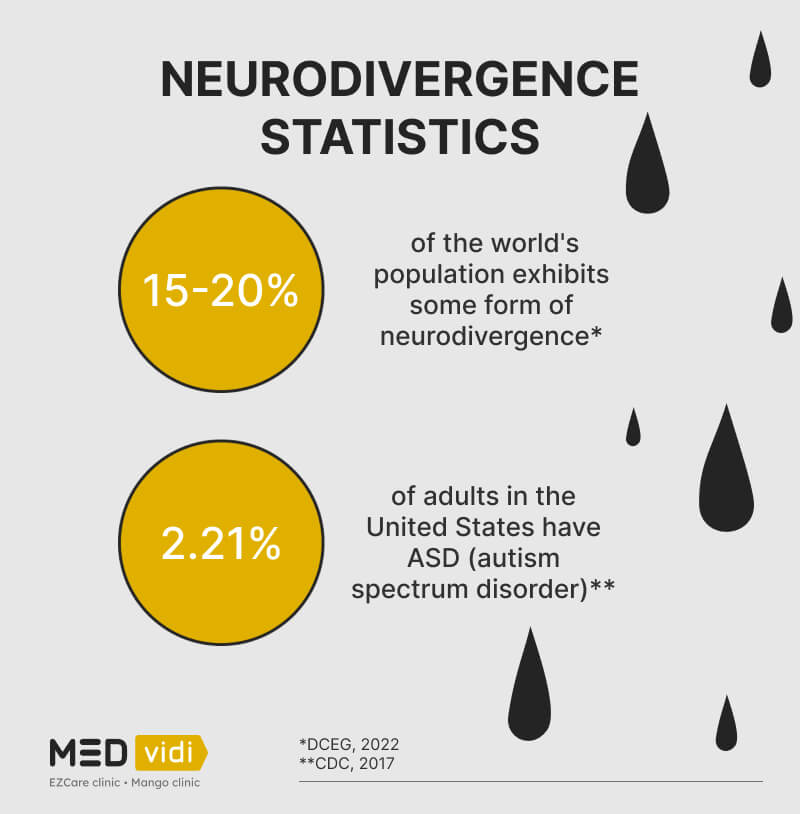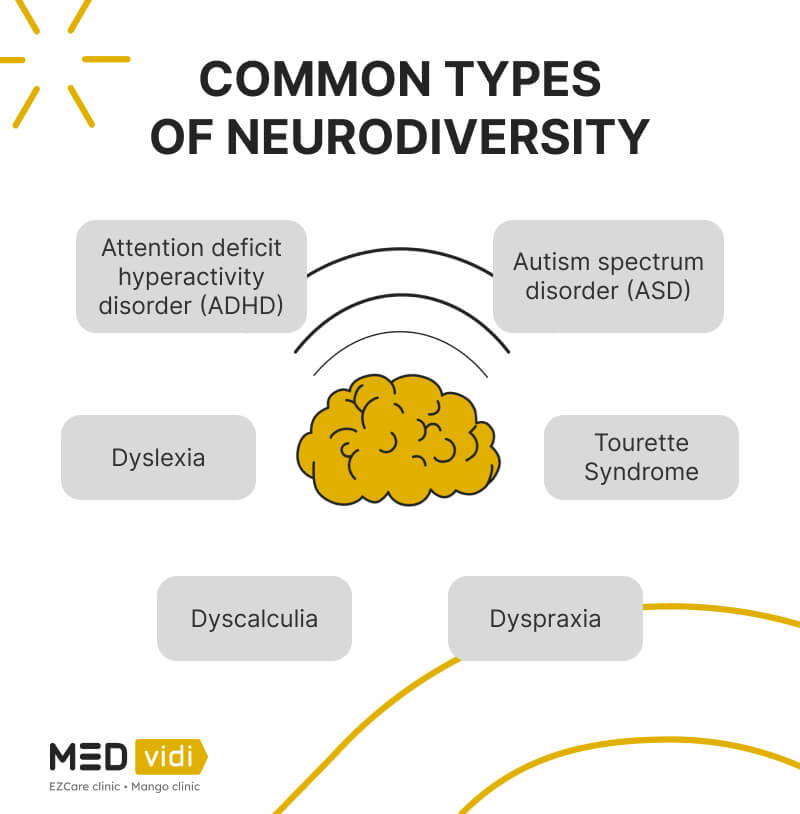Highlights
- Neurodivergence means that brain functioning is different from what is considered usual.
- Neurodiversity embraces the idea that everybody’s brain works uniquely and that neurodivergence is a normal variation.
- It is estimated that up to 2 out of 10 people are neurodivergent.
- The
four most common[1] forms of neurodivergence are ADHD, autism, obsessive-compulsive disorder, and dyslexia.
Just like fingerprints, every human brain is unique. Although we have varied skills, preferences, and personalities, we generally perceive the world in more or less the same way. This is because most people share universal similarities in how their brains are structured and function.
You might have heard the terms neurodiversity and neurodivergence; they sound almost identical and are often used interchangeably, but there is a subtle difference.
In this article, you will learn what all these terms mean, about the types of neurodiversity, how being neurodivergent impacts daily life, and how to manage it.
Neurodivergent vs Neurotypical
In order to understand the difference between neurodivergent and neurotypical, we need to break these terms down.
“Neuro” = the brain and nervous system, which control how we think, feel, and experience the world.
“Typical” = usual, common or normal.
“Diverge” = go in a different direction, not the usual path.
This makes it easier.
Classically, neurotypical refers to how the brain processes thoughts, learns, and behaves in most people;
Next, let’s look at the difference between neurodivergence and neurodiversity.
Differences Between Neurodivergence and Neurodiversity
So, neurodivergence means that brain functioning differs from usual; what about neurodiverse?
“Diverse” = varied or a mixed bag.
In the mid-1990s,
These days,
Neurodivergent Symptoms
So, how would you know if you or someone you know might be neurodiverse?
There are common neurodivergent traits or characteristics that you might recognize, such as:
- Sensory distortions: actively seeking sensory stimulation or being extremely sensitive to sensory stimuli.
- Social differences: exhibiting unique behavior in social interactions and relationships.
- Executive functioning challenges: difficulties with planning, organization, and behavior regulation.
- Intense focus on special interests: the unique ability to concentrate intensely on specific subjects or tasks.
- Exceptional artistic creativity: excelling in drawing, music, or innovation.
- Variability in math and technology: demonstrating either exceptional abilities or difficulties.
- Empathic and justice-oriented mindset: overwhelming empathy for others and a strong sense of fairness and social justice.
- Intense emotional experiences: experiencing mood swings that can be difficult to control.
- Language abilities: exhibiting enhanced language learning skills or struggling to learn specific languages.
- Thinking outside the box: possessing a gift for unconventional or innovative thinking.
- Memory variations: demonstrating either ‘photographic’ memory capabilities or extreme difficulties with working memory.
- Pattern recognition and attention to detail: skillful in recognizing patterns and small details.
- Intrusive thoughts: unwanted, unprovoked, disturbing thoughts that cause distress.
- A need to move: being restless or requiring movement breaks to maintain focus and regulate energy levels.
- Stimming: engaging in self-stimulatory behaviors to regulate sensory input and emotional states.
- Unique gender and sexual orientation outlooks.
Note that these characteristics can manifest differently, and not all neurodivergent individuals will exhibit every trait mentioned.
Neurodivergent Examples
About
Neurodiversity Present at Birth (Congenital)
1. Clinical Neurodiversity
- Attention deficit hyperactivity disorder (ADHD)
- Autism spectrum disorder (ASD)
- Tourette syndrome
2. Applied Neurodiversity
- Dyslexia
- Dyscalculia
- Dysgraphia
- Dyspraxia or developmental coordination disorder (DCD)
Neurodiversity Acquired After Birth
3. Neurological or Acquired Brain Injury (ABI) After Birth
- Traumatic Brain Injury (TBI)
- Stroke-related cognitive changes
- Long COVID cognitive effects
- Epilepsy
- Multiple Sclerosis (MS) cognitive effects
- Parkinson’s disease
- Chronic fatigue syndrome
- Cancer treatments
4. Psychiatric
a. Mental health conditions that might resolve
- Depression
- Anxiety disorders
- Post-traumatic stress disorder (PTSD)
- Obsessive-compulsive disorder (OCD)
b. Mental health conditions that are life-long
- Bipolar disorder
- Schizophrenia
- Borderline personality disorder (BPD)
Other Neurodiversity Causes (Congenital)
a. Gene variations
- Down Syndrome
- Fragile X Syndrome
- Williams Syndrome
b. Environmental exposures in the womb
- Alcohol exposure
- Drug/medication exposure
- Infections that the mother has had
- Oxygen deprivation

Common Neurodivergent Types in More Detail
Clinical Neurodiversity
Clinical neurodiversity refers to the congenital neurological differences that are considered health conditions. This category of neurodiversity is related to difficulties in communication skills, social skills, behavior, and impulse control. Clinical neurodiversity involves several disorders, which we’ll discuss in detail below.
Attention Deficit Hyperactivity Disorder (ADHD)
ADHD is a

ADHD is categorized into three types depending on the predominant symptoms:
Importantly, the expression of symptoms may change over time. Although online screening tests for ADHD are helpful, a doctor must make the diagnosis.
Autism Spectrum Disorder (ASD)
It is a common neurodevelopmental disorder; according to the CDC, in 2020, it affected approximately
Common signs that a person with ASD might manifest include:
- Not responding to their name
- Making limited eye contact
- Interpreting language literally
- Repeating phrases
- Repeating movements (e.g., hand-flapping)
- Having difficulty expressing emotions
- Having obsessive interests
- Experiencing difficulty with friendships
- Exhibiting a sensitivity to particular tastes, smells, or sounds
Symptoms typically
ASD is a spectrum disorder, meaning individuals exhibit widely varying symptoms and severity. For example, some may excel in learning and problem-solving, becoming self-made entrepreneurs, while others face significant difficulties in the same area, not finishing school. As a result, support needs also differ, ranging from extensive assistance to independent living.
Tourette Syndrome
Tourette syndrome is a neurological condition that causes unwanted involuntary tics — sudden twitches, movements, or sounds that individuals repeatedly perform. These tics cannot be controlled and are comparable to hiccups.
- Motor tics involve body movements;
- Vocal tics are sounds produced by the voice.
Symptoms typically begin between 5 to 10 years of age, often starting with motor tics in the head and neck area. Tics tend to worsen in stressful or exciting situations but improve during calm activities or those requiring increased focus.
The types and frequency of tics can change over time. Despite symptoms appearing, disappearing, and reappearing, Tourette syndrome is considered a life-long condition.
Applied Neurodiversity
Dyslexia
- Slow reading and writing
- Challenges with organization and planning,
- Letter reversals,
- Trouble following written instructions,
- Inconsistent spelling.
Dyscalculia
- Understanding quantities
- Remembering numbers
- Connecting numerals with words
- Comprehending math logic
- Recalling math facts
- Estimating measurements
Diagnosis is based on evaluation by using different tests for children and adults. The causes of dyscalculia remain unclear, but studies suggest a possible link to genetics or brain development deficits.
Dyspraxia
Signs of dyspraxia include having:
- Disturbed coordination, being awkward or clumsy
- Difficulty with time management and organization
- Challenges in learning and memory
- Social interaction difficulties
- Struggles with daily living skills
Unfortunately, dyspraxia can significantly impact daily functioning; however, having goal-orientated support, self-help strategies, and professional help from physiotherapists or occupational therapists can help improve symptoms.
Acquired Neurodiversity
Acquired neurodiversity involves neurological differences that
Acquired Brain Injuries (ABI)
Acquired brain injuries (ABI) encompass brain injuries occurring after birth, and their effects on the brain can cause either permanent damage or temporary conditions. Types of ABI include, but are not limited to, traumatic brain injury (TBI), stroke, and encephalitis. Let’s look at each of these in more detail:
- TBI is caused by head trauma, and symptoms can range from mild to severe. Its signs include a loss of consciousness, memory loss, neurological deficits, and altered mental status.
- A stroke occurs when the blood supply to the brain is interrupted, resulting in symptoms such as difficulty speaking, paralysis or numbness, vision problems, and headaches.
- Encephalitis is inflammation of brain tissue due to infection or an autoimmune response. Symptoms include flu-like symptoms, altered mental state, cognitive impairment, fever, seizures, and headache.
Other illnesses and their treatments, such as Parkinson’s disease, chronic fatigue syndrome, and specific cancer treatments, can also lead to neurological conditions.
Mental Health Illnesses
Acquired Potentially Temporary Mental Health Conditions
Rather than being a separate category, mental conditions also come under the category of acquired neurodiversity. These may include episodic conditions temporarily affecting a person’s thinking, like depression, anxiety, and obsessive-compulsive disorder.
The risks for these potentially short-lived conditions under the umbrella of neurodiversity vary, including side effects of medications, traumatic events, and exposure to certain substances.
|
Obsessive Thought |
Rituals or Compulsive Behavior Symptoms |
|
A fear of contamination |
Repeatedly washing hands |
|
The need for order |
Arranging things in a specific pattern |
Acquired Life-Long Mental Health Conditions
Bipolar disorder and schizophrenia are examples of neurodivergence that, although they start later in life, are considered life-long conditions.
Intellectual Disability
- an IQ below 70;
- significant limitations in two or more adaptive areas;
- onset must occur before age 18.
Although many times it is difficult to identify the causes of intellectual disability, the risks for congenital abnormalities are genetic problems (e.g., chromosome abnormalities) and environmental hazards in the womb (e.g., alcohol or maternal measles), or birth complications (e.g., birth asphyxia, meaning a lack of oxygen).
The most common preventable cause of intellectual disability is fetal alcohol syndrome; Down syndrome is the highest-ranked chromosomal cause, while Fragile X syndrome is the most prevalent genetic cause.
In addition, after birth, infections such as measles or meningitis, or head trauma can also lead to intellectual disability.
Importantly, people with certain neurodivergent conditions can also have intellectual disability, but not everyone with that same condition will have an IQ less than 70.

Strengths and Challenges of Neurodiversity
With everything you’ve read so far, you will understand that neurodiversity comes with many challenges, but believe it or not, there are also superpowers. Let’s look at some common strengths and challenges.
|
STRENGTHS |
CHALLENGES |
|
|
Neurodivergence: A Norm or a Disability
Remember that neurodivergence means that brain functioning differs from what is considered usual, and neurodiversity embraces this as a normal variant of human diversity.
So, why is being neurodivergent often viewed as a disability?
Unfortunately, the way the world works is mainly designed by and for neurotypical brains; understandably, people considered as having neurodivergent disorders might have challenges in school, at home, and in the workplace.;
Despite this, being diagnosed as neurodivergent does not automatically qualify as a disability, which only applies if essential functioning is permanently affected. Even then, the terms “diagnosis” and “disability” are not inherently negative in the case of neurodiversity, as they can provide legal protection, special education, workplace accommodations, and research funding.
It is essential to realize that neurodiversity is an important aspect of human diversity. Learning about disability laws is essential for proper support and protection.
Neurodiversity in Society and the Workplace
A person with neurodiversity could be seen as a ‘
Benefits of Embracing Neurodiversity
If co-workers and the public could accept neurodiversity and let go of stigma, there would be numerous benefits. The neurodiverse person will have improved self-image and confidence and be less prone to depression and anxiety. Also, people around them will meet someone empathetic, creative, and interesting, and advantages for employers could be empowering:
- Breakthroughs in science and technology
- Increased productivity (neurodiverse hires are 90-140% more productive, based on the results of the Autism at Work initiative at JPMorgan Chase).
- High staff retention due to loyalty.
It makes sense to promote neurodivergent-inclusive work environments.
Challenges and Support Mechanisms
Many people in the workplace don’t understand neurodiversity or feel uncomfortable with anything or anyone different. This could be changed by:
- Having compulsory training for managers on how to support neurodiverse employees.
- Organizing awareness campaigns.
- Forming neurodiversity support groups at work.
- Assigning senior staff as role models.
- Covering the topic during new staff orientation.
- Encouraging kindness in the workplace.
- Creating inclusive environments.
Creating Inclusive Environments
Creating a neurodiversity-friendly workspace can be achieved in various ways:
- Allowing fidget toys, standing desks, or frequent breaks.
- Clear communication.
- Having a buddy system or mentors.
- Reducing noise or allowing noise-cancelling earphones.
- Allowing speech-to-text, or text-to-speech software.
- Providing training about planning and organization.
- Providing counseling services for emotional support.
- Acknowledging achievements.
It is
Summary
Neurodiversity means accepting that everyone is unique and that differences are not a shortfall. Understanding this can be a game-changer, increasing awareness, challenging stereotypes, and creating a compassionate environment can help people learn, function, and thrive in society and the workplace.
FAQs
Is neurodiversity a disability?
What is the most common type of neurodivergence?
Attention deficit hyperactivity disorder (ADHD)
Is neurodiversity genetic?
Is there any test for neurodiversity?
There are no tests like bloodwork or scans that can diagnose neurodiversity. Although online quizzes may screen for neurodivergence, you should consult a healthcare professional for accurate evaluation and diagnosis.
Can neurodiversity be cured?
Is anxiety neurodivergent?
Yes, anxiety and depression might be considered temporary neurodivergent conditions if changes in thought patterns and behavior are extreme, but people
What conditions are considered neurodivergent?
Brain structure variation usually causes the well-known characteristics of neurodivergent or neurodiverse conditions, such as differences in thought, perception, and behavior. Structural brain change can occur because of genetics and environmental influences affecting brain development (e.g., ADHD, autism spectrum disorder, schizophrenia), chromosome changes (e.g., Down syndrome), or injury or illness later in life (e.g., stroke or brain trauma).












